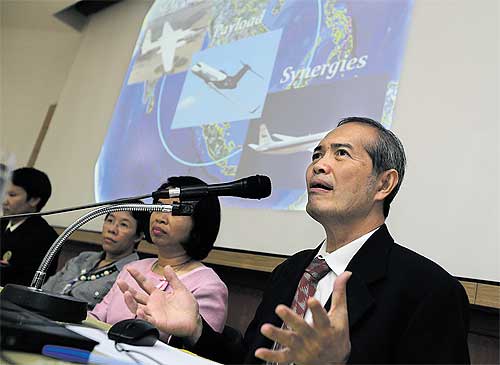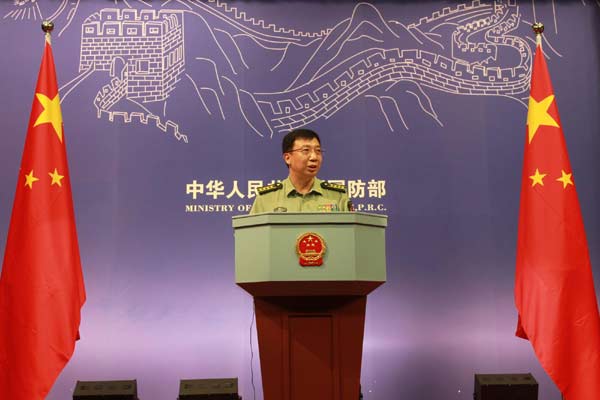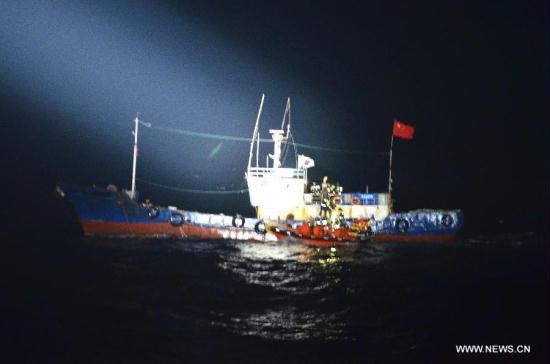MANILA, Philippines - A total of 28 Chinese ships and boats are still in Panatag (Scarborough) Shoal, 23 of them inside the lagoon of the disputed area, according to the latest aerial surveillance by the Philippine Navy.
The Navy’s aerial surveillance revealed that six fishing vessels and 17 dinghies or small boats are inside the lagoon, contrary to an earlier claim by the Department of Foreign Affairs (DFA) that China had pulled all its vessels from the area.
Navy chief Vice Adm. Alexander Pama said the remaining vessels – three Chinese maritime surveillance vessels (CMS) and two fishery and law enforcement command (FLEC) ships – are outside the lagoon.
The aerial surveillance was conducted by a Navy islander plane last Monday, the same day the DFA announced that China had pulled out its vessels from the lagoon.
Pama, however, said the DFA’s statement might have been based on previous reports.
He said China is merely rotating its vessels in the area, which is well within the Philippines’ exclusive economic zone.
 There are also indications that Chinese boats are conducting fishing activities despite the fishing ban separately declared by China and the Philippines last month.
There are also indications that Chinese boats are conducting fishing activities despite the fishing ban separately declared by China and the Philippines last month.
“Apparently that’s (fishing) what they are doing in that area,” Pama said when asked if China is violating its own fishing ban.
He said no Philippine fishing boats were spotted in the area due to the fishing ban imposed by the Philippine government.
Despite the continued presence of Chinese vessels in the shoal, it remains unclear whether the Philippines would send its ships back.
“There are no instructions yet (to send back ships to the shoal). But in fairness, the weather is bad. The waves are huge. Our ships may not be able to handle it,” Defense Secretary Voltaire Gazmin said.
Malacañang refused to comment on whether Chinese vessels were indeed “crowding” Panatag that could lead to accidents in the shoal.
Presidential spokesman Edwin Lacierda said they have to verify the reports of overcrowding of Chinese vessels in the area.
“That’s something that we’ll have to verify with MARINA (Maritime Industry Authority), with the Philippine Navy. We don’t have the data on that. if it’s really crowding the waters. But certainly we have a number of imports and exports going on so we use seafaring – the boats and the ships – for our exports and imports. But as to the term ‘crowding the waters’ that’s something that I will have to verify first,” Lacierda said.
On June 15, President Aquino directed two Philippine ships to pull out of Panatag Shoal due to bad weather. Ordered to return to port were a Coast Guard ship and a Bureau of Fisheries and Aquatic Resources vessel, which have symbolized the country’s claim over the area.
Foreign Secretary Albert del Rosario said they would evaluate whether the ships would be sent back to the shoal once the weather improves.
The DFA had also claimed China would also pull out its ships but this was later denied by Beijing.
Beijing’s denial dashed hopes that the standoff, which triggered fresh tensions in the West Philippine Sea, was nearing its end.
Last week, Aquino said the government is ready to send ships back to the shoal if Chinese vessels remain in the area.
But Malacañang has yet to order the return of Philippine ships despite the latest surveillance report by the Navy.
Gazmin supported the redeployment of Philippine vessels to the shoal, saying China could take advantage of their absence to boost its claim.
Last Monday, the DFA said China had pulled out all its boats from the shoal’s lagoon following an agreement with the Philippines that sought to ease tensions.
Del Rosario said China and the Philippines had reached a verbal agreement to pull out from the lagoon but not the wider vicinity of the shoal.
He said all Chinese boats had left the lagoon as of Saturday.
“It has been confirmed by the Philippine Navy (PN) that, as of two days ago, there were no more ships inside the lagoon. The Chinese fishing boats have obviously returned,” the DFA said in a statement yesterday.
Foreign Affairs spokesman Raul Hernandez said the DFA has made its recommendation to President Aquino after the Chinese vessels returned.
“The DFA has made its recommendation and let’s wait for the decision of higher authorities,” he added.
On the other hand, Gazmin, when asked whether he believes China lied to the Philippines about the vessels inside the lagoon, replied: “We don’t want to react on that but what we are giving you are the factual operational reports.”
Panatag Shoal is located 124 nautical miles from the nearest base point in Zambales. It is within the Philippines’ 200-nautical mile exclusive economic zone as provided by the United Nations Convention on the Law of the Sea (UNCLOS) to which China is a signatory.
A standoff ensued on April 10 after Chinese maritime surveillance ships stopped the Philippine Navy from arresting Chinese fishermen who had engaged in illegal fishing and harvesting of endangered marine species in the area.
The Philippines has protested the Chinese vessels’ action but China has insisted that it has sovereignty over the area.
Both countries support peaceful means to resolve the dispute despite reports of bullying by Chinese ships of Filipino vessels and fishermen.-The Philippine Star (June 27, 2012)

 "The Chinese military's resolve and will to defend territorial sovereignty and protect our maritime rights and interests is firm and unshakeable," Geng added, according to a transcript posted on the ministry's website (www.mod.gov.cn).
"The Chinese military's resolve and will to defend territorial sovereignty and protect our maritime rights and interests is firm and unshakeable," Geng added, according to a transcript posted on the ministry's website (www.mod.gov.cn). Last week China said it "vehemently opposed" a Vietnamese law asserting sovereignty over the Paracel and Spratly Islands, which straddle key shipping lanes thought to contain rich energy reserves.
Last week China said it "vehemently opposed" a Vietnamese law asserting sovereignty over the Paracel and Spratly Islands, which straddle key shipping lanes thought to contain rich energy reserves.

































_departs_Joint_Base_Pearl_Harbor-Hickam_for_a_scheduled_six-mont.jpg)
.jpg/300px-USS_Louisville_(SSN-724).jpg)

